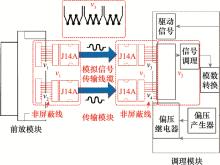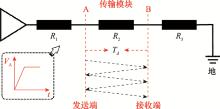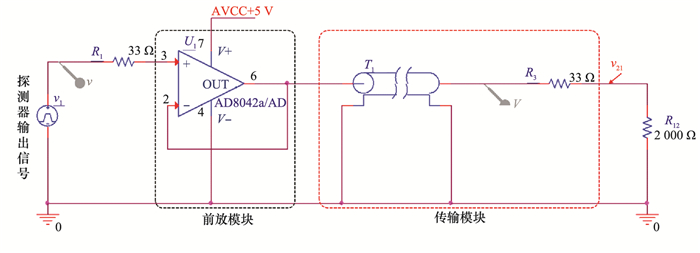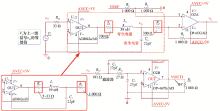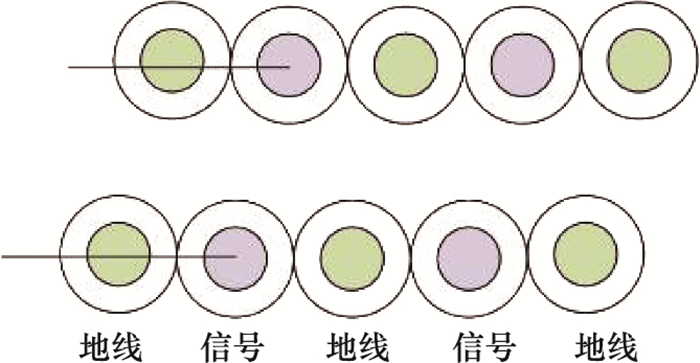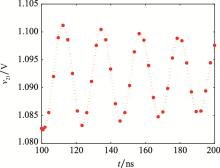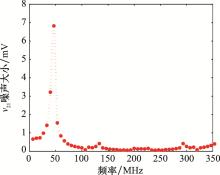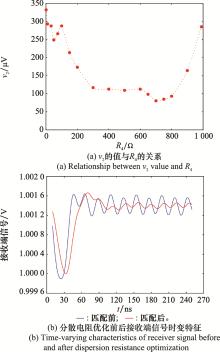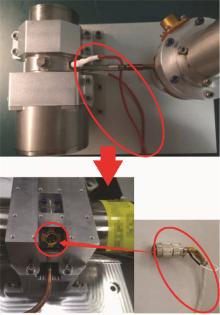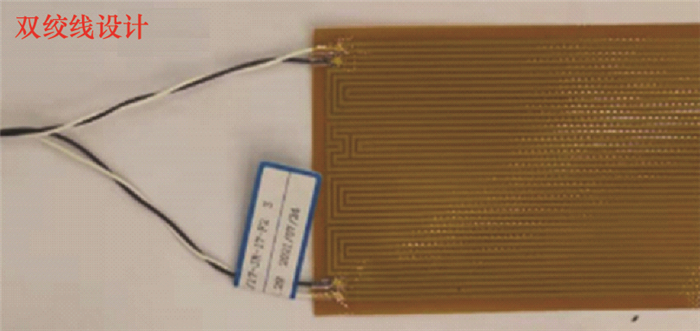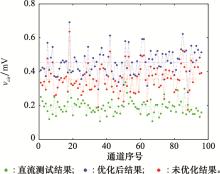Systems Engineering and Electronics ›› 2023, Vol. 45 ›› Issue (4): 950-957.doi: 10.12305/j.issn.1001-506X.2023.04.02
• Electronic Technology • Previous Articles
Circuit noise optimization method based on signal random fluctuation characteristics
Yujun TANG1,2, Jingwen ZHANG1,2, Ping CAI1,2, Zhuoyue HU1, Xinyue NI1,*, Fansheng CHEN1,3
- 1. Key Laboratory of Intelligent Infrared Perception, Shanghai Institute of Technical Physics, Chinese Academy of Sciences, Shanghai 200083, China
2. University of Chinese Academy of Sciences, Beijing 100049, China
3. Hangzhou Institute for Advanced Study, University of Chinese Academy of Sciences, Hangzhou 310024, China
-
Received:2022-02-09Online:2023-03-29Published:2023-03-28 -
Contact:Xinyue NI
CLC Number:
Cite this article
Yujun TANG, Jingwen ZHANG, Ping CAI, Zhuoyue HU, Xinyue NI, Fansheng CHEN. Circuit noise optimization method based on signal random fluctuation characteristics[J]. Systems Engineering and Electronics, 2023, 45(4): 950-957.
share this article
| 1 |
GAO Y D , LI F D , SHEN Z X , et al. Simulation method and its test verification of cryogenic infrared lens design[J]. Infrared and Laser Engineering, 2021, 50 (5): 20200397.
doi: 10.3788/IRLA20200397 |
| 2 | KLIPSTEIN P C, AVNON E, AZULAI D, et al. Type Ⅱ superlattice technology for LWIR detectors[C]//Proc. of the SPIE Defence+Security, 2016. |
| 3 | SUNDARAM M, REISINGER A, DENNIS R, et al. 1024×1024 LWIR SLS FPAs: status and characterization[C]//Proc. of the SPIE, 2012. |
| 4 | ROGALSKI A. Next decade in infrared detectors[C]//Proc. of the Electro-Optical and Infrared Systems: Technology and App-lications, 2007. |
| 5 | 辛世杰. 红外辐射基准载荷的高精度温控信息获取与处理技术[D]. 北京中国科学院大学, 2021. |
| XIN S J. High precision temperature control information acquisition and processing technology for infrared radiation reference satellites[D]. Beijing: University of Chinese Academy of Sciences, 2021. | |
| 6 | YANG M F, LIANG S L. Application of HyperLynx in the development of high speed signal processing circuits[C]//Proc. of the IEEE 5th International Conference on Computer and Communications, 2019: 655-659. |
| 7 | XU K H, ZHOU J, LIU Y, et al. Signal integrity research of high speed circuit of embedded system[C]//Proc. of the 4th International Conference on Frontier of Computer Science and Technology, 2009: 473-477. |
| 8 | CHEN X M, GUO J X. Design of a high-speed multi-channel data acquisition system based on FPGA[C]//Proc. of the International Conference on Virtual Reality and Intelligent Systems, 2020: 250-252. |
| 9 |
LENG W X , HE J X . Electromagnetic compatibility analysis of high-power pulse drive source[J]. Journal of Power and Energy Engineering, 2020, 8 (7): 32- 44.
doi: 10.4236/jpee.2020.87003 |
| 10 | TANG H, WANG H W, CAO J Z, et al. A CMOS high speed imaging system design based on FPGA[C]//Proc. of the Applied Optics and Photonics China, 2015. |
| 11 | ZHU D P, ZHAN W D, TIAN Y, et al. Design of low noise electrical system for uncooled long wave infrared imaging[C]//Proc. of the IOP Conference Series: Materials Science and Engineering, 2020, 768(6): 062026. |
| 12 | JIANG Q, XIE G Z, XIONG L X, et al. Research of the effects of TEC on UFPA noise performance[C]//Proc. of the 6th International Symposium on Advanced Optical Manufacturing and Testing Technologies: Optoelectronic Materials and Devices for Sensing, Imaging, and Solar Energy, 2012: 841923. |
| 13 |
LV J , ZHONG H , ZHOU Y , et al. Model-based low-noise readout integrated circuit design for uncooled microbolometers[J]. IEEE Sensors Journal, 2013, 13 (4): 1207- 1215.
doi: 10.1109/JSEN.2012.2230621 |
| 14 | LIU D H , LU W G , LEI S Y , et al. Low-noise readout circuit for thermo-electrical cooler-less uncooled microbolometer infrared imager[J]. Image and Vision Processing and Display Technology, 2016, 52 (9): 705- 706. |
| 15 | ALTUN O, TASDEMIR F, NUZUMLALI O L, et al. Low-noise readout circuit for SWIR focal plane arrays[C]//Proc. of the SPIE Defense+Security, 2017. |
| 16 | CHEN Z, QIU Y H, WEN Y, et al. Noise model and simulation analysis of the low noise pre-amplifier of CCD camera[C]//Proc. of the SPIE, 2014. |
| 17 | WU X Y, CUI J Y, XU C X, et al. The design of laser detection circuit with high reliability and large dynamic range based on APD[C]//Proc. of the SPIE, 2018. |
| 18 |
刘宁, 陈钱, 顾国华, 等. 640×512红外焦平面探测器前端噪声分析及抑制技术[J]. 红外技术, 2010, 32 (10): 572- 582.
doi: 10.3969/j.issn.1001-8891.2010.10.004 |
|
LIU N , CHEN Q , GU G H , et al. The noise analysis and inhibition technology of the driving circuits of the 640×512 IR focal plane detector[J]. Infrared Technology, 2010, 32 (10): 572- 582.
doi: 10.3969/j.issn.1001-8891.2010.10.004 |
|
| 19 |
MA R , GONG J Q , LIU G C , et al. Enabling cognitive pyro-electric infrared sensing: from reconfigurable signal conditioning to sensor mask design[J]. IEEE Trans.on Industrial Informatics, 2020, 16 (7): 4436- 4446.
doi: 10.1109/TII.2019.2944700 |
| 20 | CHAI H J, ZENG C L, WU Q C, et al. Design of signal conditioning circuit based on MEMS acceleration sensor[C]//Proc. of the International Conference on Integrated Circuits and Microsystems, 2016: 16598999. |
| 21 | VEJDANI P, ALLIDINA K, NABKI F. Ultra-high sensitivity, low-power dual chopper signal conditioning circuit for integrated sensors[C]//Proc. of the 14th IEEE International New Circuits and Systems Conference, 2016. |
| 22 |
PALAPARTHY V S , DODDAPUJAR S N , GUPTA G , et al. E-Nose: multichannel analog signal conditioning circuit with pattern recognition for explosive sensing[J]. IEEE Sensors Journal, 2020, 20 (3): 1373- 1382.
doi: 10.1109/JSEN.2019.2946253 |
| 23 | SU L , JIANG H B , DONG W . The high speed low noise multi-data processing signal process circuit research of remote sensing[J]. Proceedings of the SPIE, 2013, 8908 (2): 165- 189. |
| 24 | DAI L Q, ZHANG X, XU L N, et al. Design and performance of a signal process system for spaceborne multispectral imaging spectrometer covering VIS to LWIR[C]//Proc. of the Conference on Infrared, Millimeter-Wave, and Terahertz Technologies V, 2018. |
| 25 | FAN B, HAN Z X, MA F, et al. A design on low noise imaging circuit for SWIR sensor[C]//Proc. of the SPIE/COS Photonics Asia, 2016. |
| 26 | XING Y M, ZHOU Y. Design of the acquisition system with low noise based on 160×120 Uncooled infrared detector[C]//Proc. of the 5th International Symposium on Advanced Optical Manufacturing and Testing Technologies, 2010. |
| 27 |
FENG S Y , XIE B R , LIU1 Y L , et al. The system design based on long-wave uncooled infrared detector[J]. Journal of Physics: Conference Series, 2020, 1633 (1): 012015.
doi: 10.1088/1742-6596/1633/1/012015 |
| 28 | ZHU W S, WANG Y G, HUANG D J, et al. High-speed low-noise test system for IRFPA[C]//Proc. of the International Conference on Electronics, Communications and Control, 2011: 1480-1484. |
| 29 | JIA T S, XUE Y L, CUI K, et al. A high-speed and low-noise intelligent test system for infrared detectors[C]//Proc. of the SPIE/COS Photonics Asia, 2016. |
| 30 | DI L M , LIU H , WEI R Y , et al. Design of a low noise area array CCD imaging system for exoplanet search[J]. Journal of Imaging Science and Technology, 2020, 64 (3): 30504. |
| 31 |
SPRAFKE T , BELETIC J W . High-performance infrared focal plane arrays for space applications[J]. Optics and Photonics News, 2008, 19 (6): 22- 27.
doi: 10.1364/OPN.19.6.000022 |
| 32 | BAI Y B, TENNANT W, ANGLIN S, et al. 4K×4K format 10μm pixel pitch H4RG-10 hybrid CMOS silicon visible focal plane array for space astronomy[C]//Proc. of the SPIE, 2012. |
| 33 | KANGASLAHTI P, BROWN S, PADMANABHAN S, et al. High resolution microwave radiometer in AMR-C on sentinel-6[C]// Proc. of the 6th Workshop on Advanced RF Sensors and Remote Sensing Instruments, 2019. |
| 34 |
MAIWALD F , BROWN S T , KOCH T , et al. Completion of the AMR-C instrument for Sentinel-6[J]. IEEE Journal of Selected Topics in Applied Earth Observations and Remote Sensing, 2020, 13, 1811- 1818.
doi: 10.1109/JSTARS.2020.2991175 |
| 35 |
CHENG Y . Study on the methods of noise reduction in signal processing circuit of CCD remote sensor[J]. Advanced Materials Research, 2011, 317/319, 984- 987.
doi: 10.4028/www.scientific.net/AMR.317-319.984 |
| 36 | ZHANG S, BU F L, GUAN S M. Design and realization of drive circuit for uncooled infrared focal plane array[C]//Proc. of the International Conference on Computer, Mechatronics and Electronic Engineering, 2016. |
| 37 | ZHENG L , TIDROW M . Analysis of infrared focal plane array figure of merit and its impact on sensor system trades[J]. Infrared Physics & Technology, 2009, 52 (6): 408- 411. |
| 38 | ESPINOLA R L, O'SHEA P, ZEIBEL J G, et al. The impact of spatio-temporal focal plane array nonuniformity noise on target search and identification performance[C]//Proc. of the SPIE, 2008. |
| 39 | ISOZ W, SVENSSON T, RENHORN I. Nonuniformity correction of infrared focal plane arrays[C]//Proc. of the SPIE, 2005. |
| 40 | NI X Y , YU S T , SU X F , et al. Detection spectrum optimization of stealth aircraft targets from a space-based infrared platform[J]. Optical and Quantum Electronics, 2021, |
| 41 | WANG X, LIU G R, TANG J C, et al. Design of EMBCCD high voltage multiplier clock driving circuit in lowlight level imaging system[C]//Proc. of the International Conference on Optical Instruments and Technology, 2013. |
| 42 | 高晋占. 微弱信号检测[M]. 2版 北京: 清华大学出版社, 2011. |
| GAO J Z . Weak signal detection[M]. 2nd ed Beijing: Tsinghua University Press, 2011. | |
| 43 | 李亚明, 于金旭, 齐胜利, 等. 导电纤维编织宇航轻型屏蔽射频同轴电缆的研制[J]. 光纤与电缆及其应用技术, 2017, 4, 9- 13. |
| LI Y M , YU J X , QI S L , et al. Development of conductive fiber braided astronautic light shielded RF coaxial cable[J]. Optical Fiber & Electric Cable and Their Applications, 2017, 4, 9- 13. | |
| 44 | 唐清君, 陈厚磊, 梁惊涛, 等. 空间微小脉冲管制冷机研制[J]. 航空学报, 2018, 39 (S1): 9. |
| TANG Q J , CHEN H L , LIANG J T , et al. Development of space miniature pulse tube cryocooler[J]. Acta Aeronautica et Astronautica Sinica, 2018, 39 (S1): 9. |
| No related articles found! |
| Viewed | ||||||
|
Full text |
|
|||||
|
Abstract |
|
|||||
